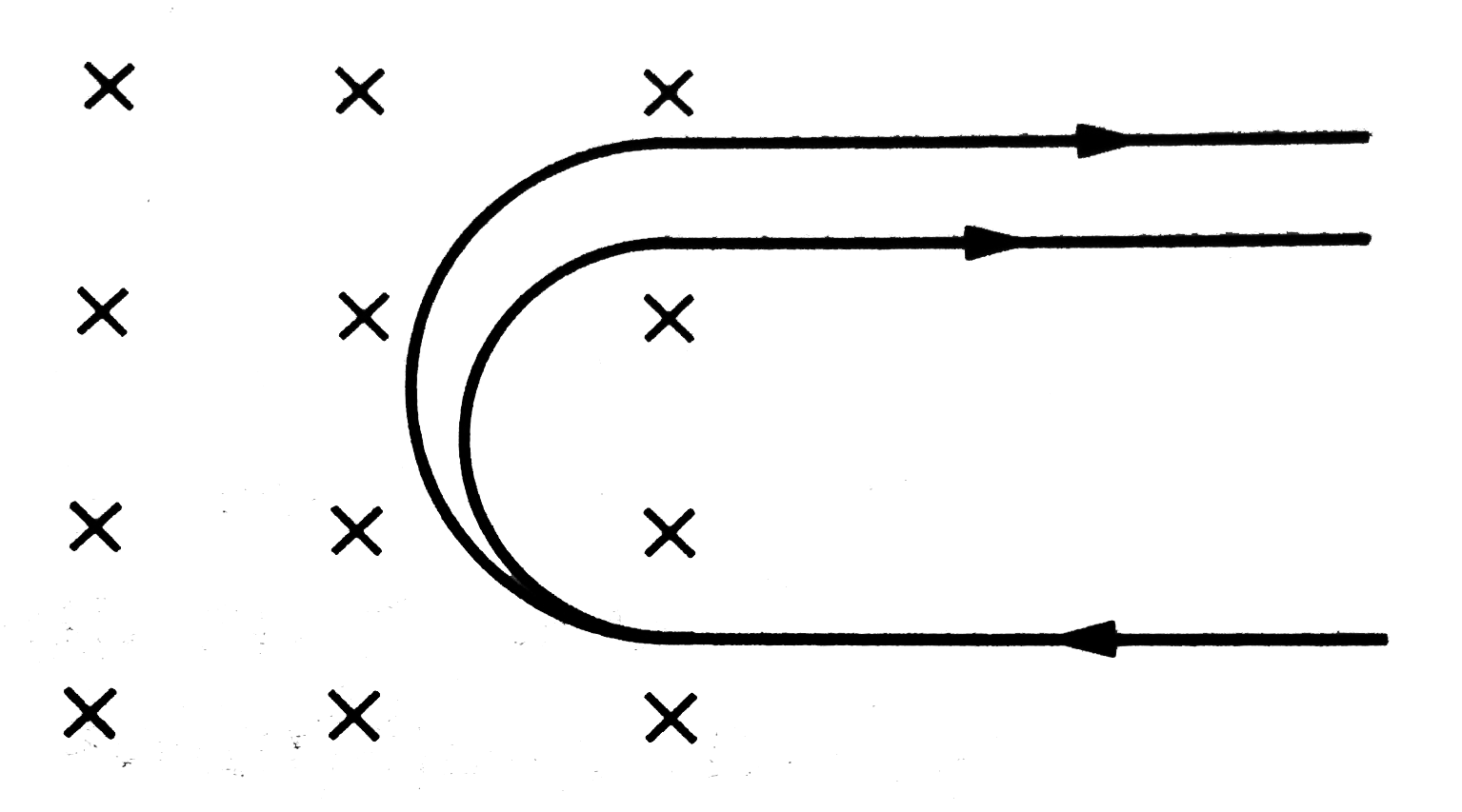Two types of particles having same charge equal to +2e but different masses are moving with a constant velocity of 6×104 m/s in the form of a beam. These particles suddenly encounter a perpendicular magnetic field in a rectangular region having intensity equal to 0.5 T. It is found that particles emerge from the field in the backward direction from two different points. These points are at a distance 3 cm and 3.5 cm from the incident beam. Find the ratio of their masses.
To solve the problem of finding the ratio of the masses of two particles with the same charge moving in a magnetic field, we will follow these steps:
Step 1: Write down the given data
- Charge of the particles, q=+2e=2×1.6×10−19C
- Magnetic field intensity, B=0.5T
- Velocity of the particles, v=6×104m/s
- Distances from the incident beam where particles A and B emerge: dA=3cm=0.03m and dB=3.5cm=0.035m
Step 2: Calculate the radius of the circular paths
The radius r of the circular path followed by a charged particle in a magnetic field is given by the formula:
r=mvqB
For particle A:
rA=dA2=3cm2=1.5cm=1.5×10−2m
For particle B:
rB=dB2=3.5cm2=1.75cm=1.75×10−2m
Step 3: Calculate the mass of particle A
Using the formula for the radius, we rearrange it to find the mass m:
mA=qBrAv
Substituting the values:
mA=(2×1.6×10−19C)(0.5T)(1.5×10−2m)6×104m/s
Calculating this gives:
mA=(1.6×10−19)(0.5)(1.5×10−2)6×104=0.4×10−25kg
Step 4: Calculate the mass of particle B
Similarly, for particle B:
mB=qBrBv
Substituting the values:
mB=(2×1.6×10−19C)(0.5T)(1.75×10−2m)6×104m/s
Calculating this gives:
mB=(1.6×10−19)(0.5)(1.75×10−2)6×104=0.46×10−25kg
Step 5: Find the ratio of the masses
Now, we can find the ratio of the masses mAmB:
mAmB=0.4×10−250.46×10−25=0.40.46≈0.87
Final Answer
The ratio of the masses of the two particles is approximately:
mAmB≈0.87
- Charge of the particles, q=+2e=2×1.6×10−19C
- Magnetic field intensity, B=0.5T
- Velocity of the particles, v=6×104m/s
- Distances from the incident beam where particles A and B emerge: dA=3cm=0.03m and dB=3.5cm=0.035m
The radius r of the circular path followed by a charged particle in a magnetic field is given by the formula:
r=mvqB
For particle A:
rA=dA2=3cm2=1.5cm=1.5×10−2m
For particle B:
rB=dB2=3.5cm2=1.75cm=1.75×10−2m
Using the formula for the radius, we rearrange it to find the mass m:
mA=qBrAv
Substituting the values:
mA=(2×1.6×10−19C)(0.5T)(1.5×10−2m)6×104m/s
Calculating this gives:
mA=(1.6×10−19)(0.5)(1.5×10−2)6×104=0.4×10−25kg
Similarly, for particle B:
mB=qBrBv
Substituting the values:
mB=(2×1.6×10−19C)(0.5T)(1.75×10−2m)6×104m/s
Calculating this gives:
mB=(1.6×10−19)(0.5)(1.75×10−2)6×104=0.46×10−25kg
Now, we can find the ratio of the masses mAmB:
mAmB=0.4×10−250.46×10−25=0.40.46≈0.87
The ratio of the masses of the two particles is approximately:
mAmB≈0.87
Topper's Solved these Questions
- MOVING CHARGES AND MAGNETISMBOOK - MODERN PUBLICATIONCHAPTER - MOVING CHARGES AND MAGNETISMEXERCISE - PRACTICE PROBLEMS
59 Videos
- MOVING CHARGES AND MAGNETISMBOOK - MODERN PUBLICATIONCHAPTER - MOVING CHARGES AND MAGNETISMEXERCISE - Conceptual Questions
29 Videos
- MAGNETISM AND MATTERBOOK - MODERN PUBLICATIONCHAPTER - MAGNETISM AND MATTEREXERCISE - CHAPTER PRACTICE TEST FOR BOARD EXAMINATION
16 Videos
- NUCLEIBOOK - MODERN PUBLICATIONCHAPTER - NUCLEIEXERCISE - CHAPTER PRACTICE TEST FOR BOARD EXAMINATION
15 Videos
Similar Questions
A narrow beam of singley charged carbon ions, moving at a constant velocity of 6.0X104ms−1, is sent perpendicularly in a rectangular region having uniform magnetic field B=0.5 T . It is found that two beams emerge from the field in the backward derection, the separations from the incident beam being 3.0 cm and 3.5cm. Identify the isotopes persent in the ion beam. Take the mass of an ion = A(1.6X10−27 kg, where A is the mass number.

View SolutionA charged particle entering a magnetic field from outside in a direction perpendicular to the field
View Solution
Knowledge Check
When a charged particle moves perpendicular to a magnetic field, then:
Aspeed of the particle is changedBspeed of the particle remains unchangedCdirection of the particle remains unchangedDacceleration of the particle remains unchangedWhen a charged particle moves perpendicular to a magnetic field, then:
Aspeed of the particles is changedBspeed of the particle remains unchangedCdirection of motion of the particle remains unchangedDacceleration of the particle remains unchangedA charged particle moves through a magnetic field perpendicular to its direction. Then
AAcceleration remain unchangedBvelocity remains unchangedCspeed of the particle remains unchangedDDirection of the particle remains unchanged
Assertion : If a charged particle is moving on a circular path in a perpendicular magnetic field, the momentum of the particle is not changing,.
Reason : Velocity of the particle in not changing in the magnetic field.
View SolutionAssertion: If a charged particle is moving on a circular path in a perpendicular magnetic field, the momentum of the particle is not changing.
Reason: Velocity of the particle in not changing in the magnetic field.
View SolutionA charged particle moves through a magnetic field perpendicular to its direction. Then
View SolutionA charged particle moves through a magnetic field perpendicular to its direction. Then
View SolutionA charged particle enters a magnetic field at right angles to the field. The field exists for a length equal to 1.5 times the radius of circular path of particle. The particle will be deviated from its path by
View Solution